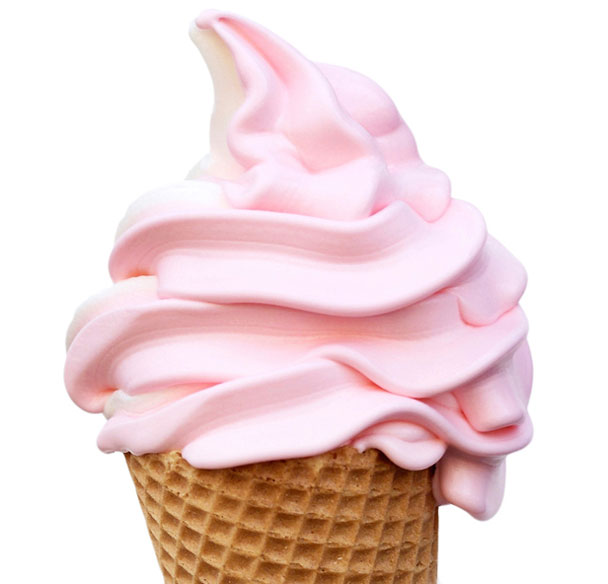Bypassing a buffet line of cookies and cakes, the frozen yogurt machine saw more action than the penny slots at the Tropicana. And with every ounce that swirled into cones and cups in cafeterias and yogurt shops across the country, frozen yogurt became the go-to alternative to traditional dessert.
Claims of low calorie, low fat and fat-free fro-yo swept the nation, and in 1981, TCBY, or The Country's Best Yogurt, ushered frozen yogurt onto the national food scene. Consumers could splurge on an entire cup of their Golden Vanilla soft serve for just 240 calories and virtually no fat. Within three years, the single store multiplied into 102 stores nationwide.
The trend persisted through the 80s and 90s, but it wasn't until 2005 and the opening of a California-based chain called Pinkberry, that frozen yogurt hit it big. Pinkberry's arrival launched the concept of “live active cultures” from laboratory obscurity to pop-cultural phenomenon. Paris Hilton could now be named in the same sentence as “probiotics,” as every pint-sized Hollywood starlet from Taylor Swift to Audrina Patridge were snapped indulging.
Stars and everyday consumers alike were hooked on Pinkberry. The product had somehow managed to achieve the oxymoronic status of a dessert that not only tasted great, but was also great for you. Companies touted the health benefits of the frozen yogurt's probiotic component, which according to Dr. Arun Bhunia, a professor of Food Science at Purdue University, included helping people to “avoid lactose intolerance and control pathogens in the gut, but also can improve gut health in helping strengthen the immune system.”
A small size cup of Pinkberry's Original flavor was just 150 calories. And with toppings like mango, kiwi, strawberries and pineapple, adding a scoop of fresh fruit only seemed to sweeten the positive points for diet and nutrition. The chain was an instant success.“Around Los Angeles you see as many Pinkberrys as you do Starbucks,” says Christine Avanti, a Los Angeles-based nutritionist who first heard about Pinkberry through one of her celebrity clients.
Like a true pioneer, Pinkberry became the standard as others tried to capitalize on the model of success. Red Mango, BerryLine, Kiwiberri, Yogen Früz, Berry Chill — nearly every corner of the nation embraced the deep freeze, and more importantly its delusive health claims.
Consumers flocked to Pinkberry's open doors, praising it on review sites like Yelp and even Zagat, where it was often referred to as “crackberry.”
“With only about 125 calories, it's a great healthy dessert choice,” wrote one Yelp reviewer about Pinkberry's Santa Monica Boulevard location in southern California. “... I happen to love yogurt, especially with fruit, and the fact that it's frozen just makes it feel like I'm eating ice cream. Very healthy ice cream,” writes another.
The frozen yogurt swirled at Pinkberry, Red Mango and other popular stores is defined by its creamy consistency and noticeably sour taste. So sour in fact that it's hard to believe that there's even any sugar in it. But taste can be deceiving. And it is this deception that results in many frozen yogurt fanatics reaching for their sweats instead of skinny jeans.
Frozen yogurt is most basically an “ice cream substitute made with yogurt instead of cream,” according to Dr. Marion Nestle, a professor in the Department of Nutrition, Food Studies and Public Health at New York University and author of Food Politics: How the Food Industry Influences Nutrition and Health. Like regular yogurt, it is made via the process of fermentation, which begins by inoculating pasteurized milk with living cultures such as Streptococcus thermophilus, Lactobacillus bulgaricus and Lactobacillus acidophilus.
“During fermentation, these bacteria convert lactose to make acid, which is lactic acid,” says Dr. Bhunia. “And it is that acid that makes the yogurt tart.”
A fully fermented yogurt then heads for the freezing process, and it is at this point that the life expectancy of the probiotics comes into question.
Lowering the temperature “may kill some of the bacterial populations,” says Dr. Bhunia. “But I don't think it'll completely kill off all the bacteria. ” Others, like Dr. Nestle, argue that “most of [the probiotics] die when frozen.”
Regardless, the quantity of probiotics in a single serving of frozen yogurt is simply not enough to outweigh the detrimental diet effects of the single ingredient required to achieve frozen yogurt's characteristically creamy texture. And this is where sugar comes in.
“You can make frozen yogurt creamy with lots of fat or lots of sugar,” says Mike Schwartz, a chef instructor at The Institute of Culinary Education in New York City. “Sugar freezes at a different temperature, so that's part of the reason why ice cream or sorbet works — it doesn't freeze hard and stays creamy.”
So while ice cream uses fat to achieve a smooth texture, low fat frozen yogurt defaults to plain old sugar. And tons of it.
At the very bottom of the nutritional listing on TCBY's home page is the sugar content of its frozen yogurt. Make a second stop at Pinkberry's nutritional listing and you'll need a calculator and an advanced degree in Mathematics to crunch out the amount of sugar in a small serving.



 Pinterest
Pinterest


